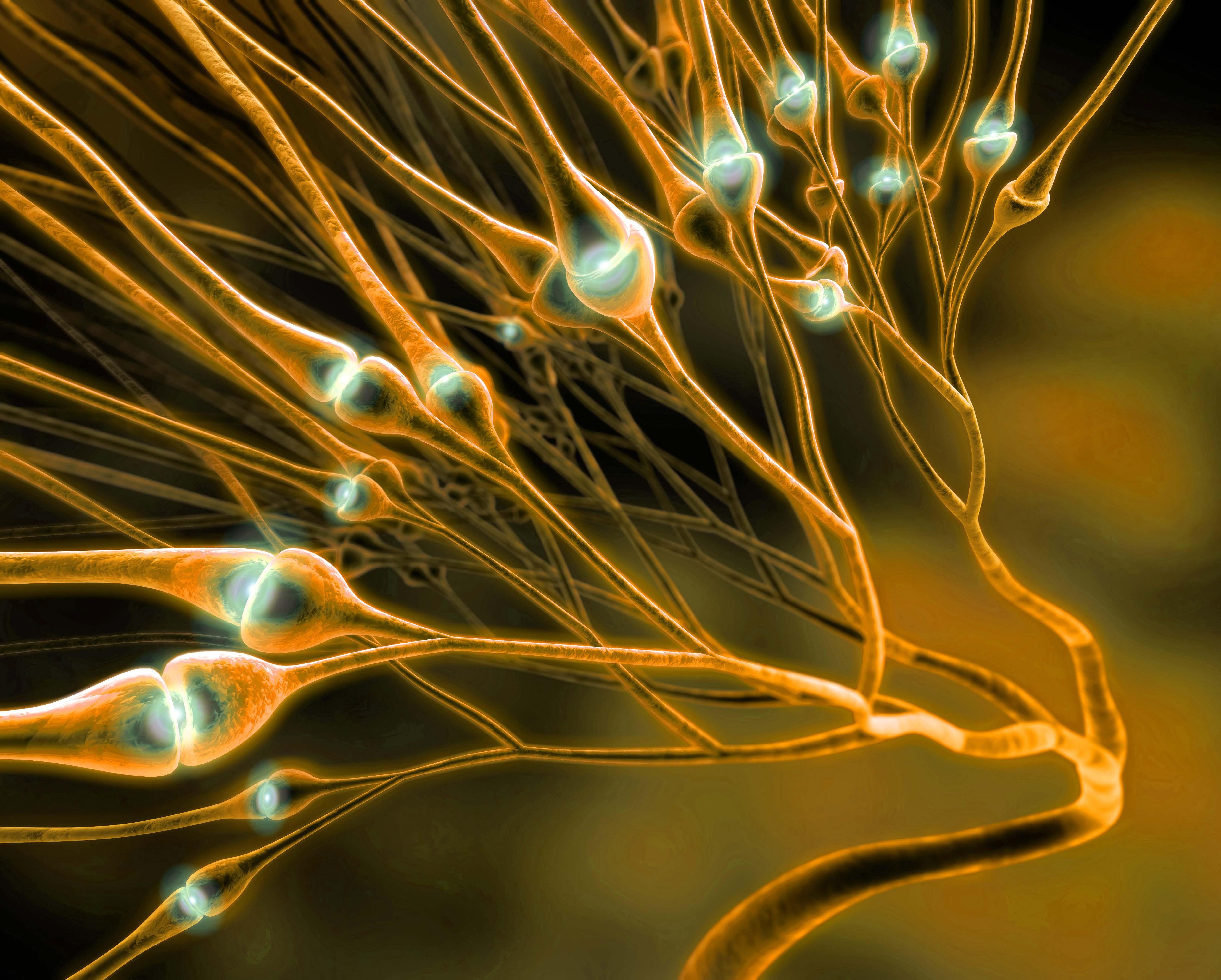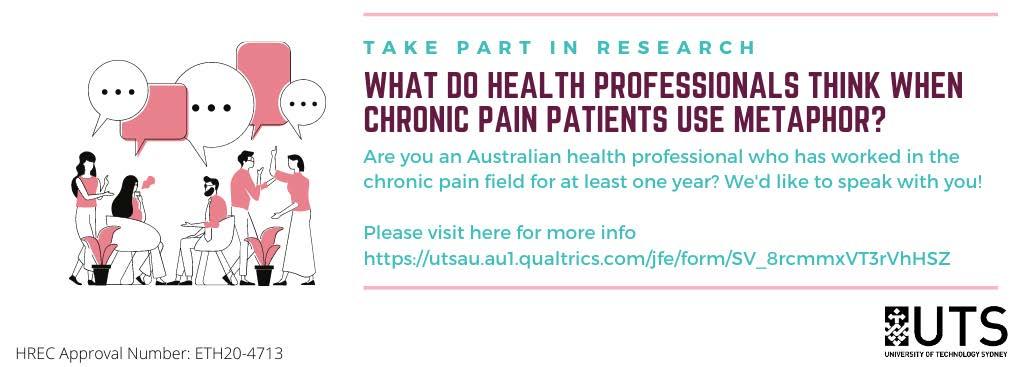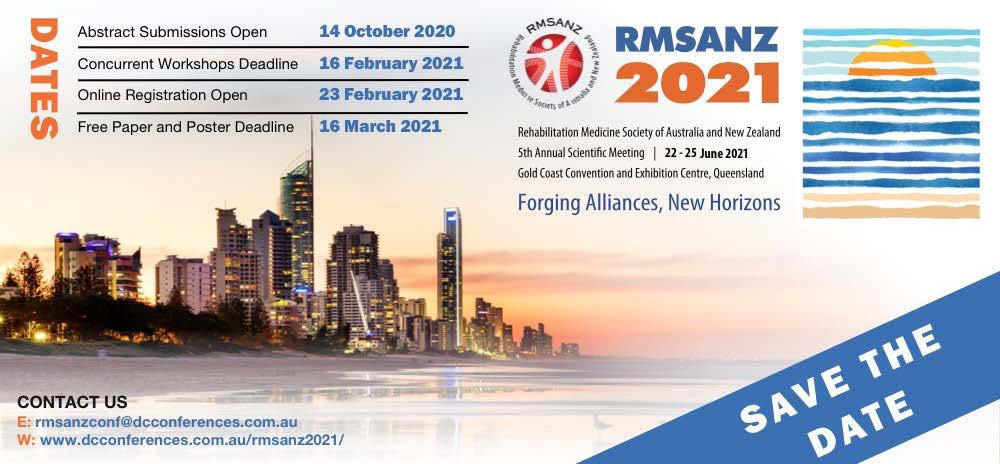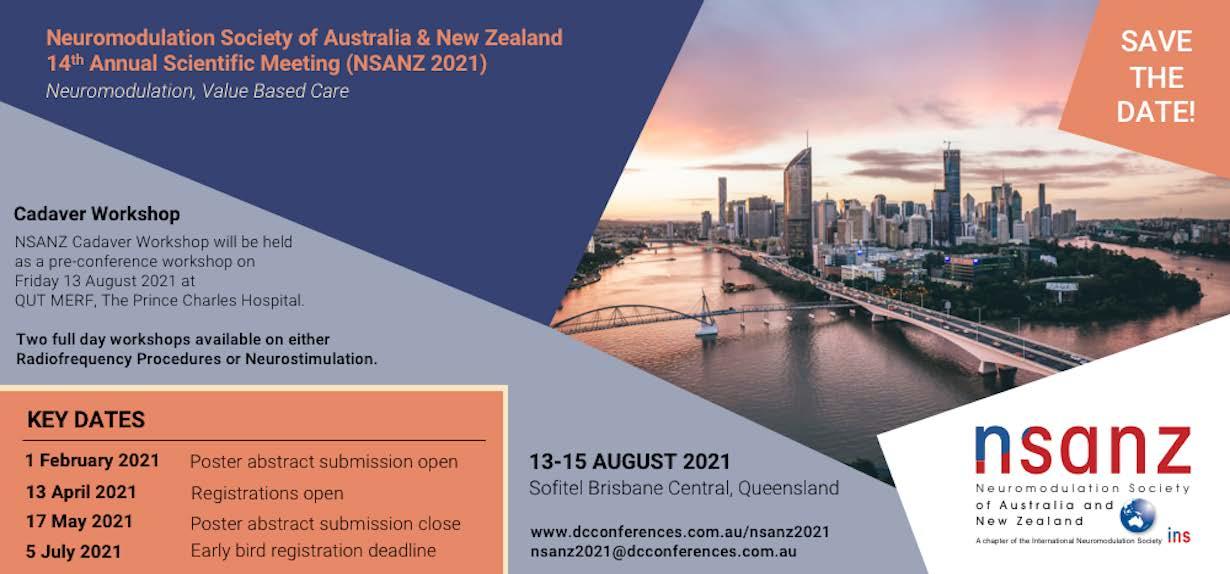Australian Pain Society NEWSLETTER









I recently attended the Strategic Planning Review Meeting for the APS Board, where I reported on eNewsletter-related activities for the previous year. There have been a variety of changes made to the eNewsletter over the past 12 months in terms of personnel, content, and appearance. One thing that (I hope) hasn’t changed, however, is our ability to keep APS members and the wider community informed and engaged with important and relevant information to assist with the mission and vision of the Society. I would like to thank Anne Burke and the Board, Tracy Hallen and the APS Secretariat, and the rest of the Editorial team for all their support and assistance with the eNewsletter over the last year. I hope that we can continue to make improvements moving forward.
I would also like to take this opportunity to encourage all members to submit your valuable contributions for the 2021 ASM—be that a topical session, free paper, or poster. While we may not know exactly what next year’s ASM will look like at this stage, I am glad that the Board and the Scientific Program Committee are working so diligently to ensure that we can proceed with an ASM. The short survey inside gives you the opportunity to help guide the ASM2021 format, we encourage you to submit your feedback.
Thanks to Dr Nicholas Veldhuis, Chair of the Basic Pain Research SIG, and his colleagues for sharing their recent paper published in the Proceedings of the National Academy of Sciences of the United States of America. This paper features important work on identifying how opioids suppress visceral pain. We encourage all members to share their new papers with us!
Dr Lincoln TracyAPS member Professor Denise Harrison and Dr Katie Birnie, (Solutions for Kids in Pain (SKIP) group, Canada) are guest editors for a special knowledge mobilisation issue on neonatal pain in Paediatric and Neonatal Pain. Part one of the special issue is available now. Keep an eye out for the part two of the special issue, which will be released in December 2020. Part two will focus on knowledge mobilisation on the context of pain in children and adults. Excellent work, Denise!
Finally, we have three great contributions from the Children’s Complex Pain Service staff at the John Hunter Children’s Hospital in Newcastle as part of the Pain in Childhood SIG Journal Watch. I found the critique of Vlaeyen and Crombez’s 2019 review paper on behavioural and learning theory literature to be particularly insightful. It’s great to see such dedication and interest from SIG members to share and highlight recent research that may be of relevance to the broader Society.
All the best.
Lincoln Tracy Editor
The Australian Pain Society is 100% committed to bringing you a conference in 2021.
You’ve told us that you missed the opportunity to connect with each other in person this year – we did too! Although we hope to meet face to face in Canberra next year, we recognise that our hold on world events is tenuous, particularly with respect to COVID-19.
We are currently working towards a hybrid format in order to give delegates the opportunity to meet in either the traditional face to face setting or via an online platform. We are also developing a virtual program so that we are prepared should it be necessary to convert to a fully online platform.
Rest assured, we will deliver you a high quality Annual Scientific Meeting where you can connect, collaborate, and learn in true APS style.
We hope that accepted authors can attend the conference to present their abstract in person, however should this not be possible due to COVID-19 related travel restrictions, the APS will work with accepted authors to convert their presentation to be streamed via an online platform.
Please submit your valuable contributions with full confidence that the APS will do whatever needs to be done in order to deliver the ASM in the safest possible way in April 2021.
Do not miss your opportunity! Submit now! www.dcconferences.com.au/aps2021
Hurry! Deadline for Submission is Tuesday 27 October 2020
There are only few weeks left to submit an abstract for inclusion in the 2021 Australian Pain Society 41st Annual Scientific Meeting. Submit your abstract before the deadline to ensure you don’t miss out!
Please note the following points regarding the submission process:
• The submitting author MUST be the main author and the person who will present the work at the ASM.
• Expressions of Interest (EOI) for travel grant applications are also being collected as part of the submission process
• Abstracts published as a digital presentation as part of APS 2020, can be resubmitted for inclusion in the APS 2021 program.
For further information, an abstract template and the submission portal please click here
For further information, an abstract template and the submission portal please click here.
For further information, an abstract template and the submission portal please click here.
Delegates wishing to apply for a PhD / Nurse / Allied Health Professional (AHP) travel grant must:
• be an APS Member
• be the major contributor and submitting author of the abstract
• complete the PhD / Nurse / AHP Travel Grant section of the abstract submission process
• complete and submit the travel grant application form
For further information, to ensure you meet the terms and conditions for travel grant applications and to complete the travel grant application form, please click here.
To view the abstract submission guidelines please click here
We look forward to receiving your submissions!
Did you run out of time to get your submission in on time?
We have extended the deadlines – so hurry and submit today!
11.59pm AEDT, Tuesday 13 October 2020
For the submission instructions and the submission portal please click here
11.59pm AEDT, Tuesday 13 October 2020
To be eligible, nominees must hold a PhD, be within 5 years of conferral by the deadline of this award application, and must be working in any field of pain research (including basic science, biomedical, clinical, and other applied or crossdisciplinary sciences).
For further information and to apply, please click here
11.59pm AEDT, Tuesday 13 October 2020
A first-time opportunity offered by Scientific Program Committee (SPC) and the Local Organising Committee to be a part of this year’s APS 2021 Pre-Conference Workshop Program.
To submit your Workshop, please click here and complete the form.
Should you have any queries regarding your submission or the process, please contact the Conference Secretariat.
We look forward to receiving your submissions!
The Australian Pain Society’s (APS) Scientific Program Committee (SPC) is working hard to bring you a fantastic Annual Scientific Meeting (ASM) in 2021.
Although we hope that we can meet face to face in Canberra, we recognise that our hold on world events is tenuous, particularly with respect to COVID-19. As such, the SPC have been hard at work developing two different formats – hybrid and virtual – so that we can be confident of delivering you an ASM in April next year.
A hybrid format will give delegates the opportunity to meet in person as well as via an online platform. A virtual format is online only and will allow us to provide high quality conference and networking opportunities when travel and personal connection are not feasible.
Rest assured, no matter the format we will make sure you have an opportunity to connect, collaborate, and learn in true APS style.
Conference planning is now well underway and we would appreciate the advice/opinion of delegates to inform our next steps. This is your conference and we want to do what we can to make sure it is delivered in a way that works for you in these uncertain times.
To complete the survey please click here
There are only 8 questions and we estimate it will take approximately 5 minutes to complete.
The deadline for responses is 11.59pm AEDT, Monday 12 October 2020.
Thank you in advance for your input.
The Board of Directors is seeking nominations from all Australian Pain Society (APS) members for candidates to be considered for the Distinguished Member Award/s to be presented at the APS 41st Annual Scientific Meeting to be held in Canberra from 18-21 April 2021.
Candidates must be APS members who generally have had a lengthy career in the field of pain and have:
• Made major contribution1 towards the Society, and
• Significantly contributed to the science of pain management, and/or
• Played a significant clinical, educational or research role in the field of Pain Management in Australia.
1 Major contributions include, but are not limited to:
– Scientific Program Committee involvement
Pain research
– APS projects
– Subcommittee involvement
– Board liaison
– Contributions to ASM presentations
NOMINATION GUIDELINES:
• A ‘Nomination for Distinguished Member Award’ form must be completed.
• As a guide, it is desirable that nominees have held continuous APS membership for over 10 years.
• Nominations must include an 800-900 word biography of the nominee. The Board will not consider incomplete nomination forms.
• Unsuccessful nominations are not automatically put forward in subsequent years.
• The nominator must be prepared to present a brief summary of the Distinguished Member biography in the ASM program, or arrange a suitable alternate for the presentation segment.
• All nominations to be submitted to the APS Secretariat by 31 October 2020.
• The APS Board will notify successful nominees by 31 December 2020.
• Distinguished Member recipients are actively encouraged to attend the Annual Scientific Meeting in order to receive their award in person from the APS President.
A listing of past recipients of the Distinguished Member Award, including their biographies, can be found on the APS website.
Thank you to APS member Dr Nicholas Veldhuis and his colleagues Dr Daniel Poole, Dr Michelle Halls, and Dr Nigel Bunnett for sharing the following recent publication.
Article first published online: 16 June 2020
Journal Reference: Proc Natl Acad Sci U S A. 2020;117(26):15281-15292.
DOI: https://doi.org/10.1073/pnas.2000500117
Link: https://www.cbns.org.au/gut-feeling-forchronic-pain-relief/

Whether G protein-coupled receptors signal from endosomes to control important pathophysiological processes and are therapeutic targets is uncertain. We report that opioids from the inflamed colon activate δ-opioid receptors (DOPr) in endosomes of nociceptors. Biopsy samples of inflamed colonic mucosa from patients and mice with colitis released opioids that activated DOPr on nociceptors to cause a sustained decrease in excitability. DOPr agonists inhibited mechanically sensitive colonic nociceptors. DOPr endocytosis and endosomal signaling by protein kinase C (PKC) and extracellular signal-regulated kinase (ERK) pathways mediated the sustained inhibitory actions of endogenous opioids and DOPr agonists.
DOPr agonists stimulated the recruitment of Gαi/o and β-arrestin1/2 to endosomes. Analysis of compartmentalized signaling revealed a requirement of DOPr endocytosis for activation of PKC at the plasma membrane and in the cytosol and ERK in the nucleus. We explored a nanoparticle delivery strategy to evaluate whether endosomal DOPr might be a therapeutic target for pain. The DOPr agonist DADLE was coupled to a liposome shell for targeting DOPr-positive nociceptors and incorporated into a mesoporous silica core for release in the acidic and reducing endosomal environment. Nanoparticles activated DOPr at the plasma membrane, were preferentially endocytosed by DOPr-expressing cells, and were delivered to DOPr-positive early endosomes. Nanoparticles caused a long-lasting activation of DOPr in endosomes, which provided sustained inhibition of nociceptor excitability and relief from inflammatory pain. Conversely, nanoparticles containing a DOPr antagonist abolished the sustained inhibitory effects of DADLE. Thus, DOPr in endosomes is an endogenous mechanism and a therapeutic target for relief from chronic inflammatory pain.
Declaration
Competing interest statement: N.W.B. is a founding scientist of Endosome Therapeutics Inc. Research in the laboratories of N.A.V., N.W.B., and D.P.P. is funded in part by Takeda Pharmaceuticals International.
Reminder that we are keen that members inform us when they have publications so that this can be shared with your APS colleagues. Please send the newsletter editor (via the APS Secretariat, aps@apsoc.org.au) the title, authors and reference (i.e. the journal, volume etc.) of the article, preferably with a short explanatory note to give our readers the gist of the article, e.g. the conclusions part of the abstract; if you would like to supply a short commentary on the article, even better.
The journal Paediatric and Neonatal Pain have a special knowledge mobilisation issue on neonatal pain. Professor Denise Harrison is the guest editor, along with Dr Birnie from the Solutions for Kids in Pain (SKIP) group, Canada.

This edition features four articles that highlight how evidence about effective neonatal pain management can be mobilised via interprofessional interventions and social media. All four papers share a focus on moving knowledge about newborn pain treatment into practice, with the aim of improving outcomes for newborn infants and their families.
The first part of the special issue focused on knowledge mobilisation can be found here
Stay tuned for part 2 of this issue in December 2020, which will focus on knowledge mobilisation in the context of pain in children and adolescents.
For more information about SKIP, click here
Vlaeyen, JW., & Crombez, G. (2019) Behavioural Conceptualization and Treatment of Chronic Pain. Annual Review of Clinical Psychology
16, 1.1-1.26. https://doi.org/10.1146/annurevclinpsy-050718-095744
Reviewers
Stuckey P, Healey A, Kepreotes EA, Lord SM. Children’s Complex Pain Service, John Hunter Children’s Hospital, Newcastle, Awabakal Country, NSW, Australia

HNELHD-CCPS@health.nsw.gov.au
Review
Vlaeyen and Crombez (2019) conducted this review of behavioural and learning theory literature, exploring its implications on our understanding and treatment of chronic pain to date. Their aim was to demonstrate a progression from the viewpoint that pain is only a sensory and emotional experience to it being ‘part of a motivational system that alarms, directs and energizes behaviour to minimise bodily harm’.
The authors acknowledge challenges in the translation of behavioural conceptualisations established from experimental laboratory research findings into effective psychological treatments for individuals with chronic pain (noting the general picture of small effect sizes to date).
Risk identification, clarification-orientated interventions, and exposure-based treatments, with the aim of facilitating the pursuit of personal valued life goals, are outlined as important recent developments in Cognitive Behavioural Therapy.
Author’s Summary Points
• The IASP definition recognises the loose connection between pain and injury: an “unpleasant sensory and emotional experience associated with, or resembling that associated with, actual or potential tissue damage.”
• The fear-avoidance model has contributed greatly to our theoretical understanding of the transition from a common pain episode to persistent pain.
• Learning enables the organism to respond to the relevance of noxious stimuli (habituation or sensitization), to predict harmful events (Pavlovian conditioning), and to prevent harmful events through avoidance behaviour (operant conditioning).
• Pain-related fear can be classically conditioned, whereas the question of whether pain itself as a response can be conditioned is still unanswered. See the imprecision theory of chronic pain - Moseley and Vlaeyen (2015).
• [The nervous systems of] individuals with disabling chronic pain seem to favour a “better safe than sorry” strategy. False alarms seem to be accepted to avoid missing a true alarm.
• Responding to noxious events takes place in the context of competing non-pain goals and needs, which may influence pain and pain avoidance.
• Exposure-based treatments can significantly reduce pain-related fear and the interference of pain in daily life. Some studies reveal a significant reduction in the report of pain intensity after pain-related fear has diminished.
The authors discuss the benefits of focussing on the Exploitation-Exploration trade-off in future directions. They refer to exploitation as maintaining the status quo, choosing behavioural actions based on existing knowledge at the cost of missing out on opportunities for improvement (pain avoidance), and exploration as gathering novel information at the risk of worsening the current situation, a curiosity stance that allowed for more varied behavioural responses in order to participate in valued activities. Finding the right balance between exploitation and exploration behaviour whilst living with pain yields a wider repertoire of responses to pain treatment and may result in the extinction of pain avoidance behaviours across contexts.
In support of the move towards a personalised pain management approach, Vlaeyen & Crombez (2019) highlight data that suggests pain reduction is not a prerequisite for a reduction in disability (de Jong et al. 2005), which can be an easy assumption to hold as health care provider or patient seeking treatment.
This review is extremely useful in the understanding and clinical treatment of chronic pain and disability across the lifespan from a behavioural perspective. Vlaeyen and Crombez explore the influence of verbal information provided by peers, family, and healthcare workers on fear learning and how we make sense of pain. It has been found that there is no difference in fear conditioning via direct versus verbal learning pathways (Mertens et al. 2018). The potential clinical implications of verbal learning processes on children suffering from complex pain are interesting to consider, given children and young people are highly influenced by their family and peer systems. It supports the idea of systemic change and family behavioural interventions when working with children.
This paper points toward further promising developments in tailored, individualised, behavioural-based psychological treatments for chronic pain. Further exploration of psychological therapies underpinned by verbal learning processes and functional behavioural
contextualism such as Acceptance and Commitment Therapy were beyond the scope of this review.
With regards to approaching pain in children and adolescents, we can therefore view play elements and fun as an important contextual factor which increases desirability, drives towards safe explorations of opportunities to discover, acts as a proxy for values during their development, and allows more intrepid approaches to correctly estimated exposure to values-based activities via decreasing the threat of a perceived dangerous situation or task.
This review highlights the potential evolutionary function of pain and its ability to organise and influence an organism’s behaviour to adapt and protect itself from harm in its environment, thus reducing the behavioural repertoire in response to pain and pain-perceived stimuli (i.e., “pain is a strong driver of learning”). The conceptualisation of pain in this way lends itself to individualised tailored behavioural treatments that focus on nonpain orientated goals/values, functional analysis, and in-vivo/real-world exposure therapy involving pain-related fear induction and extinguishing processes. Current limited knowledge is acknowledged by the authors, who suggest a paradigm shift may be required in order to treat pain and pain-related disability more effectively.
Declaration
The reviewers have no competing interests to declare.
References
de Jong JR, Vlaeyen JW, Onghena P, Cuypers C, den Hollander M, Ruijork J. 2005. Reduction of painrelated fear in complex regional pain syndrome type I: the application of graded exposure in vivo. Pain 116:264-275.
Mertens G, Boddez Y, Sevenster D, Engelhard IM, De Houwer J. 2018. A review on the effects of verbal instructions in human fear conditioning: empirical findings, theoretical considerations, and future directions. Biol. Psychol. 137:49–64.
Moseley GL, Vlaeyen JW. 2015. Beyond Nociception: the imprecision hypothesis of chronic pain. Pain 156:35-38.

Whitney, D. G.; Shapiro, D. N.; Peterson, M. D.; Warschausky, S. A. published May 2019, Volume 63 (5), p 408–417. Journal of Intellectual Disability Research doi: https://doi.org/10.1111/jir.12583
Kepreotes EA, Lord SM, Healey A, Stuckey P. Children’s Complex Pain Service, John Hunter Children’s Hospital, Newcastle, Awabakal Country, NSW, Australia
HNELHD-CCPS@health.nsw.gov.au
Aim
To determine the factors associated with depression and anxiety problems in children with intellectual disability (ID) to identify those that are treatable and modifiable, as well as those deemed unmodifiable.
Retrospective cross-sectional study.
Population: Children aged 6-17 years old with ID, also known as mental retardation. ID was not defined, but was characterised as impaired intellectual and adaptive functioning.
Outcome: The primary outcome was the presence of depression and/or anxiety as reported by parent-proxy. Predictive variables included ID severity, sociodemographics, comorbid conditions (autism spectrum disorders, epilepsy, cerebral palsy, Down syndrome, and attention-deficit/ hyperactivity disorder [ADHD]), physical factors such as physical activity, sleep duration, and pain, and social factors such as participation in activities and bully victimisation.
Study design: Cross-sectional study using data from the 2016 National Survey of Children’s Health.1
The prevalence of depression and/or anxiety problems in children with ID was 35.4%. After adjusting for sociodemographics; Hispanic race was associated with lower odds [odds ratio (OR) 0.3; 95% confidence interval (CI) 0.1–0.8] of depression and/or anxiety problems. After adjusting for race, comorbid conditions, and physical and social factors, autism spectrum disorders (ASD; OR 4.4; 95% CI 1.1– 10.1), Down syndrome (OR 0.2; 95% CI 0.1–0.8), ADHD (OR 5.9; 95% CI 2.5–14.3), pain (OR 7.0; 95% CI 2.9–17.1), and bully victimisation (OR 2.3; 95% CI 1.0–5.3) were each associated with depression and/or anxiety problems.
The study2 identified ASD/ADHD (especially co-morbid ASD and ADHD), pain, and bully victimisation were each significantly associated with higher odds of depression and/or anxiety while Hispanic race and Down syndrome were significantly associated with lower odds in children with ID.
Whitney et al. have addressed the paucity of research pertaining to factors that are associated with impacts on the mental health of children with ID by using data from a national health survey to quantify the prevalence and identify associated risk factors. Of these, chronic pain was the highest associated risk factor for developing anxiety and/or depression.
The national population sampling procedures are well described, noting the response rate of 69.7% and accounting for non-response data and oversampling. The study population (n = 576,666) was extracted from all children aged 6-17 years (n = 48,795,382), reflecting a prevalence rate of 1.2%, consistent with prevalence estimates of ID in the United States of America in 20112013. Parent-reported data for one child per household were used in the analysis.
Pain was described as a dichotomous variable from the survey question that asked if the child had ‘FREQUENT or CHRONIC difficulty’ with ‘repeated or chronic physical pain, including headaches or other back or body pain’. Pain was identified in 22.2% of the 423 children with ID (95% CI 13.7-30.6). The multivariate logistic regression analysis identified that anxiety and/or depression in children with ID was 7 times more likely to occur (95% CI 2.9-17.1) if pain was present.
This represents important information for paediatric chronic pain services that seek to provide care for vulnerable children. Children with ID have a known risk for mental ill-health due to the physical and social factors that limit independent functioning, their integration in society, and the transitional periods from childhood to adulthood. Difficulties with communication may also hinder assessment and care4
In 2018, the Australian prevalence of ID in children under 15 years was 4.5% or 1:223. Examining ID in the context of Australian and New Zealand paediatric specialist pain clinics in 2018 identified a parent-reported prevalence of 3.5% in children aged 5-18 years4. These data suggest that children with ID comprise a subpopulation that may have difficulty in accessing specialist paediatric pain management services.
Whitney et al. have increased awareness of the associated impact that chronic pain can have on the mental health of children and young people living with ID. A more considered approach to chronic pain management for those with ID may include options for stage-appropriate self-report of pain and its impacts, recognising that ID
occurs across a severity scale and that increased self-determination has a role in reducing the impacts of ID.
Take-home Messages:
• Pain is associated with a 7-fold higher likelihood of anxiety and/or depression in children with ID.
• With 22% of children living with ID identified as having chronic pain, only 3.5% of children accessing ANZ specialist pain services have ID. This is less than the AU population prevalence, suggesting that there may be less recognition of chronic pain and therefore referral for treatment, or timely access to a service is an issue.
• Currently pain in children and young people with ID is reported by parent-proxy, despite ID ranging from mild to severe. Stageappropriate self-report could be considered.
• Specialist pain management teams should consider chronic pain in those with ID as a higher risk factor for anxiety and/or depression and customise programmes accordingly.
References
1. 2016 National Survey of Children’s Health Nonresponse Bias Analysis (2017) United States Department of Commerce: the Economics and Statistics Administration.
2. Whitney, Daniel G., Danielle N. Shapiro, Mark D. Peterson, and Seth A. Warschausky. “Factors associated with depression and anxiety in children with intellectual disabilities.” Journal of intellectual disability research 63, no. 5 (2019): 408-417.
3. Australian Bureau of Statistics. “Disability, Ageing and Carers, Australia: Summary of Findings, 2018” (2019). Australian Government. https://www.abs.gov.au/ausstats/abs@.nsf/ Latestproducts/4430.0Main%20 = Accessed 14/09/2020
4. Tardif, Hilarie; Blanchard, Megan B.; Quinsey, Karen; Bryce, Meredith P.; White, Janelle M.; Blacklock, Julie A.; and Eagar, Kathy, “electronic Persistent Pain Outcomes Collaboration Annual Data Report 2018” (2019). Australian Health Services Research Institute. https://ro.uow.edu.au/ ahsri/1026
Markus J, Sibbing IC, Ket JCF, de Jong JR, de Beer SA, Gorter RR. J Pediatr Surgery, published online 20th June 2020. doi: 10.1016/j. jpedsurg.2020.05.014
Lord SM, Kepreotes EA, Healey A, Stuckey P. Children’s Complex Pain Service, John Hunter Children’s Hospital, Newcastle, Awabakal Country, NSW, Australia

HNELHD-CCPS@health.nsw.gov.au
Aims
1. To review the evidence for treatments of socalled anterior cutaneous nerve entrapment syndrome (ACNES) in children; and
2. to provide treatment recommendations to clinicians.
Systematic review compliant with the Preferred Reporting Items for Systematic Reviews and Meta-Analyses (PRISMA).
Population: Children < 18 years old with ACNES defined as presence of localized abdominal pain during palpation plus a positive Carnett’s sign4 (increased pain on active head lift).
Intervention: Any treatment(s).
Comparator: Active or inactive (placebo) acceptable, but no comparator was required.
Outcome: Primary outcome was treatment success defined as ‘no pain or less pain’ at least 4 weeks post-treatment. Secondary outcomes included pain recurrence and complications.
Study designs: Eligible designs included randomised controlled trials (RCTs), literature reviews, meta-analyses, and non-randomised prospective and retrospective cohort studies.
Markus et al. did not use the Grading of Recommendations, Assessment, Development and Evaluations (GRADE) system for determining the quality of evidence and certainty of conclusions. Instead they used the Down & Black Checklist (1998).
The search strategy yielded 149 articles. Only 8 full-text articles were assessed for eligibility, with 6 articles found eligible: 2 retrospective and 4 prospective cohort studies, including a total of 224 participants. Methodological quality was rated as poor (3 studies) or fair (3 studies). There were no RCTs.
Included studies investigated two treatments:
1. local anaesthetic injected ‘into the trigger point’ (with or without ultrasound guidance; with or without corticosteroid; single or multiple injections); and/or
2. anterior neurectomy.
Treatment success varied between studies. Following injection(s) success rates ranged 2287%, and following neurectomy success rates ranged 86-100%. Despite small numbers ( < 10 participants) in one of the injection studies and three neurectomy studies, the reviewers did not report 95% confidence intervals.
Three studies reported no complications and three did not mention adverse events at all.
Two studies reported recurrence rate of ACNES after neurectomy as 8% and 42%. The functional impact of ACNES was reported as school absence pre-treatment in one study and for hindrance of school/sport activities in another. No study reported functional change post-treatment.
Authors’ conclusions
Markus et al. conceded that high quality data were lacking, but nevertheless recommended “a step-up treatment strategy” for children with ACNES. They recommend starting with injection of local anaesthetic, and reserving surgery (anterior neurectomy) for cases of persistent pain. Furthermore, based on the results of a RCT of pulsed radiofrequency neurotomy (PRF) for ACNES in adults that reported success in just 13% at 6 months post-PRF, they suggest that PRF might be an intermediary step before neurectomy in children.
This is an important clinical question because children and adolescents are increasingly referred to tertiary pain services for the management of presumptive ACNES. However, despite the promising title, this paper does not deliver sufficient evidence to inform its treatment recommendations.
Diagnostic criteria for ACNES, though not the focus of the review, are critical to evaluating its quality. Only 3 reviewed studies included altered sensation in the diagnostic criteria for this putative cutaneous neuropathic condition. The other studies relied on localised tenderness and Carnett’s sign ± a ‘positive pinch test’. Consequently, it is unclear whether all children included in the intervention studies actually had peripheral neuropathic pain mediated by a discrete anterior cutaneous nerve.
Even when peripheral neuropathic pain mediated by an anterior cutaneous nerve is present, the term ACNES remains inaccurate unless one can demonstrate both anatomical entrapment and a neural lesion. An anatomical substrate for entrapment has been proffered by Applegate1 based on gross anatomical dissection and photomicrographs. However, throughout most of the ACNES6/LACNES5/ POCNES3 clinical literature, entrapment is an assumption rather than a proven aetiology.
If inaccurate, use of the term ACNES may lead to potential iatrogenic harm for children; and parents hearing that their child’s nerve
is “entrapped”, may experience perceptions of bodily threat, feelings of helplessness, and urgent and persistent striving for “release” that drives decision-making irrespective of evidence.
High quality evidence for treatments are lacking. That there were no studies of noninvasive treatments found in the search is testament to a gap in this area. Even for the invasive treatments (injections and surgery), the reviewers found no eligible RCTs. Sample sizes for included cohort studies were too small to yield meaningful success rates; several studying fewer than 10 subjects, with no controls, let alone blinding. Included studies, particularly those evaluating neurectomy, were underpowered to evaluate safety. This is important since the only RCT in adults2 reported that of 44 procedures: localized hematoma (n = 5, conservative treatment), infection (n = 1, antibiotics and drainage), and increased local pain (n = 1) were complications.
Using the Cochrane GRADE method for nonrandomised studies of interventions, the evidence presented would start at ‘low certainty’ and be down-graded to ‘very low certainty’ due to risk of bias, inconsistency, imprecision, and publication bias. Such evidence cannot be used to inform treatment recommendations.
It is our position that these treatments should remain experimental until rigorously evaluated in children.
Take-home Messages:
• Neurosensory examination is needed to delineate discrete peripheral neuropathic pain from somatic or nociplastic pain.
• ACNES is a misnomer in the absence of proven entrapment, and may cause iatrogenic harm through patient/parent misconceptions.
• The treatment recommendations of this review are based on very low-quality evidence and on extrapolation from an adult study.
• Rigorous ethics-approved RCTs, including usual care controls, are needed before we can justify invasive procedures for this indication in childhood.
The reviewers have no competing interests to declare.
1. Applegate WV, Buckwalter NR. Microanatomy of the structures contributing to abdominal cutaneous nerve entrapment syndrome. J Am Board Fam Pract. 1997;10(5):329-332.
2. Boelens OB, van Assen T, Houterman S, Scheltinga MR, Roumen RM. A double-blind, randomized, controlled trial on surgery for chronic abdominal pain due to anterior cutaneous nerve entrapment syndrome. Ann Surg. 2013;257(5):845–849
3. Boelens OB, Maatman RC, Scheltinga MR, van Laarhoven K, Roumen RM. Chronic Localized Back Pain Due to Posterior Cutaneous Nerve Entrapment Syndrome (POCNES): A New Diagnosis. Pain Physician. 2017 Mar;20(3):E455-E458.
4. Carnett JB. Intercostal neuralgia as a cause of abdominal pain and tenderness. Surgery, Gynecology & Obstetrics, Chicago, 1926, 42: 625-632, in Carnett’s sign, Wikipedia https:// en.wikipedia.org/wiki/Carnett%27s_sign#cite_refCarnett1926_5-0
5. Maatman RC, Papen-Botterhuis NE, Scheltinga MRM, Roumen RMH. Lateral Cutaneous Nerve Entrapment Syndrome (LACNES): A previously unrecognized cause of intractable flank pain. Scand J Pain. 2017;17:211-217. doi:10.1016/j. sjpain.2017.10.007
6. Markus J, Sibbing IC, Ket JCF, de Jong JR, de Beer SA, Gorter RR. Treatment strategies for anterior cutaneous nerve entrapment syndrome in children: A systematic review. Journal of Pediatric Surgery, https://doi.org/10.1016/j.jpedsurg.2020.05.014

Ethics approval number: 202000195

Can you help to put researchers in touch with pain support groups in your area?

Dr Steve Gilbert of the North Queensland Persistent Pain Management Service is researching pain understanding and confidence using the Pain Understanding and Confidence Questionnaire (PUnCQ). Understanding is assessed using a short questionnaire of 12 multiple choice questions, based on a case history of a patient developing widespread pain after a minor accident. These cover aspects of the IASP undergraduate pain curriculum. Confidence is self-assessed and participants rate the adequacy of their undergraduate course in helping them to manage persistent pain. Studies of Scottish students found
some areas of knowledge lacking, low confidence and 85% said they would have liked more teaching. This study is now being repeated in Australia and to complement the survey, Steve is also looking to seek the patients’ views of how well prepared they thought their GP was to manage their pain.
The patients’ views survey has been developed with support group organisers and members of GAPPA - Global Alliance of Pain Patient Advocates Task Force of IASP.
If you can help put Dr Gilbert connect with local support groups, please email stephen.gilbert@ health.qld.gov.au or 163gilbert@gmail.com
(HREC approval number: HREC/QTHS/64534)








JOIN US ONLINE
#AusPainSoc
Australian.Pain.Society
@AusPainSoc
For sponsorship and exhibition opportunities or more information please contact the APS Conference Secretariat
DC Conferences Pty Ltd
P: 61 2 9954 4400
E: aps2021@dcconferences.com.au

W: dcconferences.com.au/aps2021
Allan Basbaum is a professor and Chair of the Department of Anatomy at the University California San Francisco, USA. His research addresses the molecular mechanisms that underlie the generation of persistent pain after tissue or nerve injury.

Expressions of interest online at: dcconferences.com.au/aps2021
REGISTRATIONS OPEN
4 NOVEMBER 2020
DEADLINES
Topical Sessions 28 September 2020
Free Papers & Posters 27 October 2020
Rising Star Award 27 October 2020
Early Bird Registration 23 February 2021

INCLUDING
Pre-Conference Workshops
Topical Sessions
Trainee Session
Extensive Industry Exhibition
Sponsored Sessions
Discipline Sub Group Meetings
Welcome Reception Conference Gala Dinner
Siri Leknes is a Professor of Social and Affective Neuroscience at the University of Oslo, Norway and a Senior Researcher at Oslo University Hospital. Her lab, the Leknes Affective Brain lab (LAB lab) studies how the brain and body give rise to pleasurable and painful feelings, and how these feelings are connected to decisions and behaviour.
Amanda C de C Williams is Reader (Associate Professor) in clinical health psychology at University College London; consultant clinical psychologist at the Pain Management Centre, University College London Hospital, UK; and research consultant for the International Centre for Health and Human Rights.








• Revised opioids PBS listings from 01 October 2020: https://www.pbs.gov.au/info/news/2020/09/revised-opioids-pbs-listings-from-1-october-2020
Other items of interest for our members:
• Latest opioids data from the Australian Bureau of Statistics: https://www.abs.gov.au/ausstats/ abs@.nsf/MediaReleasesByCatalogue/CC21BEAE2026450DCA25847F0013A28F?OpenDocument
• Australia’s annual overdose report 2019: http://www.penington.org.au/australias-annual-overdose-report-2019/
• The Third Australian Atlas of Healthcare Variation https://www.safetyandquality.gov.au/atlas
• Painaustralia eNewsletter latest issue, available online at http://www.painaustralia.org.au/media/enews
• ePPOC: electronic Persistent Pain Outcomes Collaboration
For more information about ePPOC, refer to the website: http://ahsri.uow.edu.au/eppoc/index.html
• PainHEALTH website
http://painhealth.csse.uwa.edu.au/
• Stanford University
CHOIR Collaborative Health Outcomes Information Registry: https://choir.stanford.edu/
• Opioid Podcasts for GPs
20 week series from the Hunter Postgraduate Medical Institute: http://www.gptraining.com.au/recent-podcasts
• Airing Pain
Pain resources via an online radio show produced by Pain Concern, a UK registered Charity: http://painconcern.org.uk/airing-pain/
• Digital Health Guide
Developed by Primary Health Network Tasmania: https://digitalhealthguide.com.au/Account/LogOn?ReturnUrl=%2fSpecialtyFormulary%2f2
At login, Username: connectingcare, Password: health
• Indigenous Resources
New webpage on the APS website aggregating Indigenous resources: https://www.apsoc.org.au/Indigenous-Resources
NPS MedicineWise resources:
• Choosing Wisely Australia – News & media: https://www.choosingwisely.org.au/news-events
• Over the counter codeine – changes to supply: https://www.nps.org.au/medical-info/clinical-topics/over-the-counter-codeine-changes-to-supply
• Medicines with codeine – what you need to know: https://www.nps.org.au/medical-info/consumer-info/medicines-with-codeine-what-you-need-to-know
• Information about opioids and chronic non-cancer pain: https://www.youtube.com/watch?v=8R4RT 0pUCf4&feature=share&fbclid=IwAR2dbhzgEAcc7B-ogq2a6Xhud5FDkbciPbdJ9pb94GnQI6pAeifGd1 VP-_I
• Codeine information hub: https://www.tga.gov.au/codeine-info-hub
NSW Agency for Clinical Innovation resources:
• Brainman and Pain Tool Kit translations, SEP15: http://www.aci.health.nsw.gov.au/chronic-pain/translated-resources
• Pain Management Resources: http://www.aci.health.nsw.gov.au/resources/pain-management
• Quicksteps to Manage Chronic Pain in Primary Care: http://www.aci.health.nsw.gov.au/chronic-pain/health-professionals/quick-steps-to-managechronic-pain-in-primary-care
- Built into Quicksteps: “How to de-prescribe and wean opioids in general practice”:
http://www.aci.health.nsw.gov.au/chronic-pain/health-professionals/quick-steps-to-managechronic-pain-in-primary-care/how_to_de-prescribe_and_wean_opioids_in_general_practice
• A list of helpful apps for consumers and clinicians now available at: http://www.aci.health.nsw.gov.au/chronic-pain/health-professionals/management-of-chronic-pain
• Chronic Pain in the ED: https://www.aci.health.nsw.gov.au/networks/eci/clinical/clinical-resources/ clinical-tools/pain-management/chronic-pain-in-the-ed
Dr Frank Buchanan Anaesthesia
Dr Geraldine Chew Addiction Medicine
Dr Jacquelyn Nash Pain Medicine Physician
Mr Jason Tan Nursing
Prof Krishna Boddu Anaesthesia
Mrs Vivien Hsu Pharmacy
Dr Zoe Vella Pain Medicine Physician
These dates and events are current at the time of publication. Due to the current health concerns with COVID-19, we recommend you make your own inquiries before planning to attend
16-18 October 2020
Australian Psychological Society Online, Virtual, Online Conference https://www.psy2020.com.au
4 -7 November 2020
Wounds Australia
Brisbane Convention and Exhibition Centre, Brisbane, QLD https://wounds2020.com.au/?utm_ source=australianpainsociety&utm_ medium=banner&utm_campaign=website
5 November 2020
Faculty of Pain Medicine (FPM) Hong Kong College of Anaesthesiologists Combined Spring Meeting Webinar
Online, Virtual, Online Conference https://www.anzca.edu.au/events-courses/ events/major-events/fpm-national-events/2020fpm-combined-spring-meeting-webinar
6-8 November 2020
European Pain Federation EFIC Online, Virtual, Online Conference https://europeanpainfederation.eu/virtual-paineducation-summit/
11 -13 November 2020
Clinical Oncology Society of Australia (COSA) Convention Centre, Brisbane, QLD https://www.cosa2020.org/
14-15 November 2020
Convenor - Dr Marc Russo
Online, Virtual, Online Conference https://dcconferences.eventsair.com/pain2020/
16-28 November 2020
RACGP - GP20
Satellite events in each Capital City, Hybrid Interactive, Online Conference
https://www.racgp.org.au/gp20/gp20-home
24-27 February 2021
Australian College of Rural and Remote Medicine (ACRRM) and Rural Doctors
Association of Australia (RDAA)
The Crowne Plaza, Hunter Valley, NSW https://rma.acrrm.org.au/covid-19-update
4-6 March 2021
Exercise & Sports Science Australia (ESSA)
Perth Convention & Exhibition Centre, Perth, WA http://researchtopractice2020.com.au
12 -14 March 2021
Australia New Zealand Headache Society Sofitel Wentworth Hotel , Sydney , NSW https://anzheadachesociety.org/2020-anzhsheadache-annual-scientific-meeting/
18-20 March 2021
New Zealand Pain Society Annual Scientific Meeting 2021
Copthorne Hotel, Bay of Islands, New Zealand https://www.nzps2021.nz
9-11 April 2021
Spine Society of Australia
International Convention Centre, Sydney, NSW https://dcconferences.eventsair.com/ssa-2021/
18-21 April 2021
Australian Pain Society 41st Annual Scientific Meeting
National Convention Centre, Canberra, ACT https://www.dcconferences.com.au/aps2021/
30 April 2021
Faculty of Pain Medicine (FPM) Symposium
2021
Melbourne Convention and Exhibition Centre, Melbourne, VIC https://www.anzca.edu.au/events-courses/ events/fpm-events/fpm-national-events/2020faculty-of-pain-medicine-symposium
19-21 May 2021
Australian & New Zealand Society for Geriatric Medicine (ANZSGM)
Sofitel Melbourne on Collins, Melbourne, VIC http://www.anzsgmconference.org/
21-23 May 2021
Australian Psychological Society College of Clinical Psychologists
Sofitel Brisbane Central, Brisbane, QLD https://www.psychology.org.au/APS-CCLINConf/2020
22-25 June 2021
Rehabilitation Medicine Society of Australia and New Zealand (RMSANZ)
Gold Coast Convention and Exhibition Centre, Gold Coast, QLD https://www.dcconferences.com.au/ rmsanz2021/
23-25 June 2021
Occupational Therapy Australia
Cairns Convention Centre, Cairns, QLD https://www.otaus2021.com.au
27 June-1 July 2021
International Association for the Study of Pain (IASP)
TBA, Amsterdam, Netherlands https://www.iaspworldcongress.org
13-15 August 2021
Neuromodulation Society of Australia & New Zealand (NSANZ)
Sofitel Brisbane Central, Brisbane, QLD https://www.dcconferences.com.au/nsanz2021/
21-23 October 2021
Australian Physiotherapy Association
Brisbane Convention and Exhibition Centre, Brisbane, QLD https://australian.physio/pd/conferences-andmasterclasses
11-13 November 2021
Australian and New Zealand Association of Oral & Maxillofacial Surgeons
Hotel Grand Chancellor, Hobart, Tasmania https://www.anzaomsconference.com.au/
24-27 March 2022
IASP Pain in Childhood SIG Cordis Hotel, Auckland, New Zealand http://www.ispp2022.nz/home.html
Vision:
All people will have optimal access to pain prevention and management throughout their life.
Mission:
The Australian Pain Society is a multidisciplinary association whose mission is to advance pain prevention, management and clinical practice.
Priorities:
In order to achieve our mission, the Australian Pain Society will provide:
• Education
• Advocacy
• Research
• Services and resources
• Membership
• Good governance and operations
President:
A/Prof Anne Burke

Central Adelaide Local Health Network
Royal Adelaide Hospital
Adelaide SA 5000
Tel: 08 7074 2835 Fax: 08 7074 6247
President-Elect:
Ms Trudy Maunsell
Acute Pain Service
Princess Alexandra Hospital
Woolloongabba QLD 4102
Tel: 07 3176 5547 Fax: 07 3176 5102
Secretary:
Dr Will Howard

VIC
Tel: 03 9496 3800
Treasurer
Mr Tim Austin
Camperdown Physiotherapy
Newtown NSW 2042
Tel: 02 9517 1787 Fax: 02 9516 2491
ACT Director:
Dr Andrew Watson



Calvary Hospital
Canberra ACT 2617
Tel: 02 6201 6352 Fax: N/A
NSW Director:
Dr Tim Ho

Inner West Pain Centre
RPA Medical Centre
Newtown NSW 2042
Tel: 02 9517 1764 Fax: 02 9517 1832
NT Director:
Ms Diann Black
Chronic Pain Service
Palmerston Regional Hospital
Holtze NT 0829
Tel: 08 7979 9502 Fax: 08 7979 9792
QLD Director:
Mrs Joyce McSwan
Gold Coast Primary Health Network
Persistent Pain Program, QLD
Tel: 0412 327 795 Fax: 07 3539 9801
SA Director:
Dr Michelle Harris


Royal Adelaide Hospital and Lyell McEwin Hospital
Adelaide SA
Email: michelle.harris2@sa.gov.au
TAS Director:
Mrs Dinah Spratt
Physiotas Physiotherapy
Shearwater TAS 7307
Tel: 03 6428 7500 Fax: 03 6424 7811
VIC Director:
Dr Laura Prendergast Pain Service




Austin Health
Heidelberg VIC 3084
Tel: 03 9496 3134 Fax: 03 9496 6337
WA Director:
Mr Shadreck Tozana
Functional Revival and Perth WA
Tel: 0437 541 165
Immediate Past President:
Ms Fiona Hodson
Hunter Integrated Pain Service
John Hunter Hospital Campus
New Lambton NSW 2305
Tel: 02 4922 3435 Fax: 02 4922 3438
SPC Chair:
A/Prof Kevin Keay



Department of Anatomy
University of Sydney
Sydney NSW 2006
Tel: 02 9351 4132 Fax: 02 9351 2817
IASP Liaison:
Professor Michael Nicholas Pain Management Research Institute
Royal North Shore Hospital
St Leonards NSW 2065
Tel: 02 9926 7894 Fax: 02 9662 6279
Website: https://www.iasp-pain.org
Communications Coordinator:
A/Prof Anne Burke
Central Adelaide Local Health Network
Royal Adelaide Hospital
Adelaide SA 5000
Tel: 08 7074 2835 Fax: 08 7074 6247
Newsletter Editor:
Dr Lincoln Tracy
School of Public Health and Preventive Medicine
Monash University
Melbourne VIC 3004
Tel: 03 9903 0288
Newsletter Assistant Editor:
Dr Joanne Harmon



School of Clinical and Health Sciences
University of South Australia
Adelaide SA 5000
Tel: 08 8302 1442
PhD Scholarship Chair:
A/Prof Michael Farrell

Department of Medical Imaging and Radiation Services
Monash University
Clayton VIC 3800
Tel: 03 9905 6094 Fax: 03 9902 9500
Secretariat:
DC Conference & Association
Management Pty Ltd
PO Box 637
North Sydney, NSW 2059
Tel: 02 9016 4343
Email: aps@apsoc.org.au
Website: apsoc.org.au